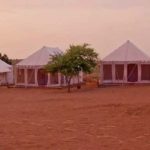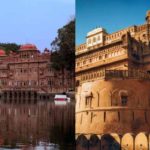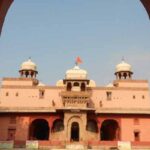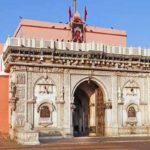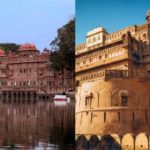Bikaner Tour Guide has a rich cultural heritage and it is home to magnificent architectural marvels. This city is situated amidst the Thar Desert and is a traveler’s paradise. It is popularly called as the ‘Camel Country’ and it is known for the best riding camels in the world. Here’s a complete Bikaner travel guide for your kind perusal.
Bikaner offers a taste of Arabian nights in India. It hosts the Bikaner Camel Festival which attracts a large number of national and international tourists. Camel safaris are the best way to soak in the spectacular beauty of the Thar Desert here. The vibrant and lively aura of the city will make you fall in love with this place. A complete Bikaner tourist guide like the one you’re reading now will let you know about much more information.
In the arid desert of Rajasthan, Bikaner Tour Guide appears to be like a beautiful oasis. The exquisite forts made up of red bricks, ancient temples, palaces, and museums present a sight to behold. This city is very popular for its delicious cuisines as well.
Some of the best Bikaner places to visit are the Junagarh Fort, Rao Bikaji Fort, Laxmi Niwas Palace, Bhandasar Jain Temple, Karni Mata Temple, Lakshmi Nath Temple, and Mukam Bishnoi Temple. The city is one of the finest destinations in north-west India which should be visited by all at least once in their lifetime Bikaner Tour Guide.
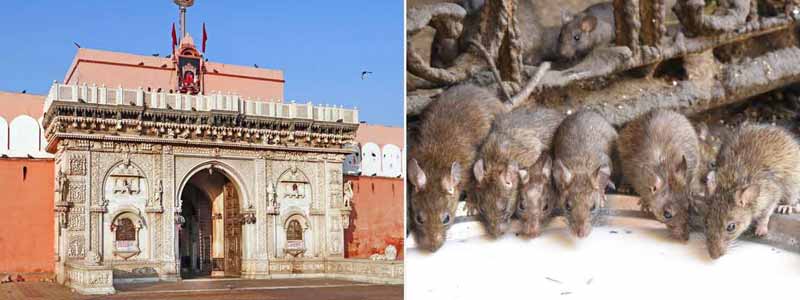
History of Bikaner, Rajasthan
Talking about the history of this colorful city of Rajasthan, it dates back to long ago in the golden pages of the book of history. It was in the 15th century that Bikaner was a barren land that was ruled by the Rajputs and was known by the name of ‘Jangladesh’. In the year 1488, the namesake city was established by Rao Bika and he even built the Junagarh fort which is now considered as a popular tourist attraction to visit in Bikaner.
You would be pleased to know that; considered as the oasis in between the Thar Desert, Bikaner served as a strategic point of trade between Central Asia and Gujarat. Specifically talking about the major construction and development that happened in Bikaner Tour Guide, then it would undoubtedly be under the rule of Raja Rai Singh. He ruled from 1571 AD till 1611 AD and even won several wars and accolades. This brave ruler even conquered the Mewar kingdom and got handsomely rewarded for the same.
It was in the 18th century that the kingdom fell into the hands of the British Empire. Though the Royal family kept ruling the city but the main control was in the hands of Britishers. Gradually, the royal family of Bikaner shifted to the Lalgarh Palace where they continued to reside till date. Owing to its interesting history, Bikaner is one of the favourite places to explore for all the history buffs.
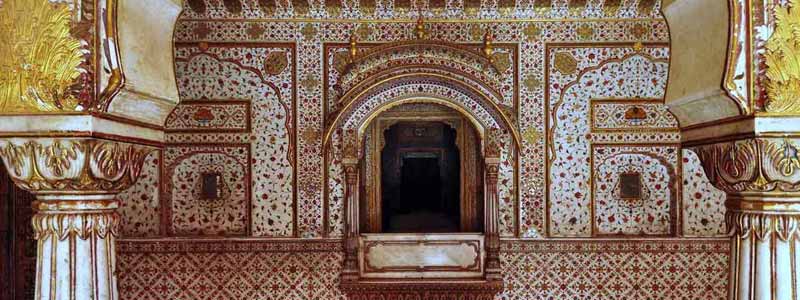
Places to Visit in Bikaner
Bikaner Tour Guide If you love to be associated with a city that has a rich cultural heritage, you need to be in Bikaner. The city was established in the year 1488 AD by Rao Bika Ji, a Rajput prince. The city is known for producing great warriors. The excavations from this city prove that the civilization was at its peak here even before Harappan civilization. Imposing palaces, forts and stunning temples with great architecture boast of the finesse of the Rajput civilization. Here are the 8 places to visit in Bikaner, which are all time favorites for tourists.
Junagarh Fort: Junagarh is an impregnable bastion that holds the distinction of having never been captured. It was constructed in 1588 AD by Raja Rai Singh, one of Emperor Akbar’s most distinguished generals. The fort complex houses some magnificent palaces constructed in red sandstone and marble and visitors can feast their eyes on an attractive assortment of courtyards, balconies, kiosks and windows.
Lal garh Palace: Maharaja Ganga Singh commissioned the construction of this majestic palace. This architectural marvel is made entirely of red sandstone and was built in 1902 to commemorate his father, Maharaja Lal Singh. The design was conceptualised by Sir Swinton Jacob, who created this oriental fantasy by blending Rajputana, Islamic and European architecture.
Ganga Museum: Described as the best museum in the State, the museum contains a rich display of archaeological artefacts from Harappa and the early Gupta periods. There are separate sections for paintings, arts and craft, woven carpets, clay pottery, ancient coins and Rajput weaponry.
Bhandasar Jain Temple: Jain Temple Bhandasar is a 15th century temple dedicated to the 5th Tirthankar (a person that has conquered the cycle of life, death and rebirth and paved the path for others to attain nirvana), Sumatinathji, and is one of the oldest monuments of Bikaner Tour Guide. The temple design includes intricate mirror work, murals and gold leaf paintings. Devotees throng to the temple from all corners of the country.
Devi Kund: 8 kilometres from Bikaner is the royal crematorium. It has several exquisite chhatris (cenotaphs), each dedicated to the memory of a ruler of the Bikaji dynasty and situated on the exact spot where each of them was cremated. The chhatri of Maharaj Surat Singh is a fine example of the architecture of that era. Devi Kund also has cenotaphs of 22 female members of the royal family prior to Maharaja Gaj Sigh Ji, who committed sati. There is also one cenotaph of a Sata (male sati) of a ruler. Maharaja Surat Singh’s Chhatri is built entirely in white marble with spectacular Rajput paintings on its ceiling.
Gajner Wild Life Sanctuary: Barely 32 kilometres from Bikaner, on the Jaisalmer road, is a lush green forest which is a haven to the nilgai, chinkara, black buck, wild boar, flocks of imperial sand grouse and many other species of migratory birds that make the sprawling forest their winter home Bikaner Tour Guide.
Gajner Palace and Lake: Gajner is an incomparable jewel of the Thar. The Gajner Palace was founded by Maharaja Gaj Singh ji of Bikaner in the year 1784, and then completed by the great Maharaja Ganga Singh of Bikaner Tour Guide on the banks of the lake. It was meant to serve as a hunting and relaxing lodge for the royal family as well as for visiting guests. It has now been converted into a hotel
Rampuria Haveli: Bikaner has several havelis (aristocratic homes), the most famous cluster being the Rampuria Group of Havelis. Built of dulmera (red) stone, every aspect of the havelis – jharokhas (casements), entrances, latticed windows, divankhanas, gumaharias or basements – is simply exotic. Leaves and flowers decorate every jharokha, lending it a pleasant touch. These massive havelis are decorated with golden work of the highest quality. Their dankhanas (drawing room) take one back to the Mughal and Rajput era. One can notice an abundance of Victorian influence in their design as well. The wood carvings in Rampuria Havelies are extremely exquisite. Spaced close to each other, the havelis are truly a sight to behold.
Laxmi Niwas Palace: Laxmi Niwas Palace was the residence of the king of Bikaner, Maharaja Ganga Singh. Built between 1898 and 1902 by British architect Sir Samuel Swinton Jacob, this structure displays an Indo-Saracenic architectural style. It is now a luxury hotel.
Deshnok Karni Mata Temple: Hinduism in India is as multifarious a religion as it is longstanding.Spirituality and symbolism happen to be its two fundamental elements. Also, a deeply involved part of these two aspects of Hinduism are animals. The assertive Hindu belief of inviolability of animals is actually one of the most remarkable aspects of the Indian culture. Bikaner Tour Guide These creatures have been reckoned as channels for love and unity, symbols of the culture and impetuses of growth, by many ancient Indian literary texts.
The life of an animal is held equal to that of a human, the only difference being that unlike the latter their senses have not fully manifested. Right from the classification of beings to the many animal incarnations of Gods, the crucial role of Nature’s beasts is furthermore stressed. The more one comes across the powerful references to animals in India, the more intrigued one gets. And it is only by visiting the numerous religious destinations within the nation, and peeking into their backgrounds that you begin to converge with the thresholds of this centuries’ old culture. Among the prominent seats of religion in India is the legendary Karni Mata Temple in Bikaner Tour Guide.
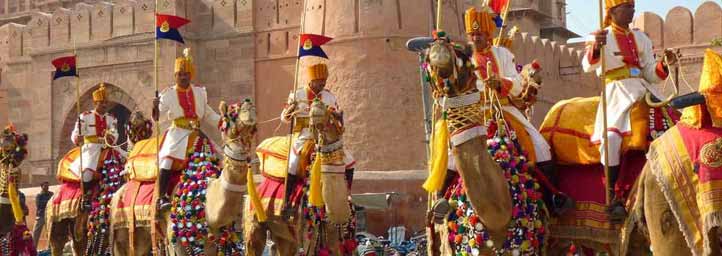
Shopping in Bikaner:
Purchase colorful and vibrant Rajasthani print from Bikaner. The markets of Bikaner Tour Guide are famous for selling local prints and handicrafts of Rajasthan. In each and every product sold you get a glimpse of Rajasthan. The famous markets in Bikaner are Kote Gate, Station Road Market, Lallgarh Palace Road, Mahatma Gandhi Road, and Bara Bazar. Purchase things like Kundan Jewelry, Sarees with bandhani or leheriya prints, lac bangles, leather mojari, Nokha razai, Bikaneri Bhujia, different varieties of churan, and sweets. Other things that one can buy from Bikaner are miniature paintings, small wooden carved objects, khadi textiles and cosmetics, utensils, embroidered and colorful bags, rugs, and chairs made out of leather.
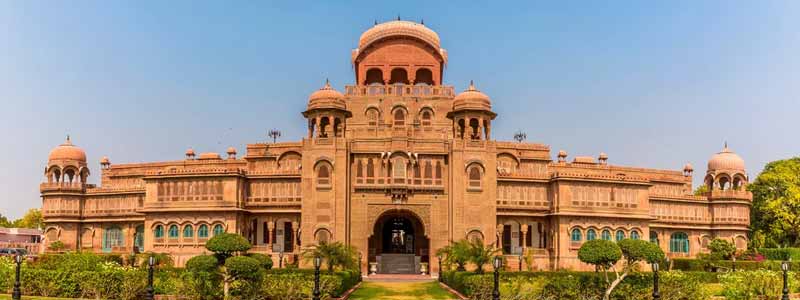
Best time to visit Bikaner:
The best time to visit Bikaner is during October to February, when the weather is cooler and much more pleasant than the summers. Visiting the city during the monsoon season is not a bad idea, considering the temperatures are lesser as compared to the summers, even though the humidity might be a problem. Visiting Bikaner Tour Guide during the summers is not advisable unless you are willing to bear the scorching desert sun. The discounts offered during the off-season here might make it worthwhile.
How to Reach Bikaner, Rajasthan?
Bikaner Tour Guide If the thing that is stressing you down is travelling issues or facing difficulty in reaching the vacation destination, we would be pleased to tell you that you will face no such thing as far as Bikaner is concerned. This popular place to visit in Rajasthan is well – connected with several major cities and states via different modes of transports. You can easily reach it:
By Air: The nearest airport to reach Bikaner is the Nal Airport. It is located close to the city and just 13 km away from Bikaner. However, it is still under construction and has not started operations yet. The next nearest airport to reach Bikaner would be the Jodhpur airport which is located at a distance of about 251 km from Bikaner Tour Guide. This airport is well – developed and well – connected with various major cities throughout the country. Once you reach the airport, you can easily take a bus or hire a taxi to reach your destination.
By Rail: There are two railway stations located close to Bikaner Tour Guide. They are Bikaner Junction and Lalgarh Railway Junction. They are located at a distance of just about 6 km from the city, so you don’t have to worry about travelling issues. These railway junctions are well – connected with a plenty of major cities including Delhi, Jaipur, Punjab, Hyderabad, Mumbai and many others too. Once you reach the station, you can easily take a cab or hire a taxi to reach your destination.
By Road: The city of Bikaner is well – connected with roads to many nearby cities. There is a regular bus service that runs from a plenty of nearby cities to Bikaner on a daily basis. You can choose between travelling from a government bus or a private bus. Taxis travelling to Bikaner Tour Guide are also easily available. Since the roads are considerably smooth, you can also travel by personal vehicle.


